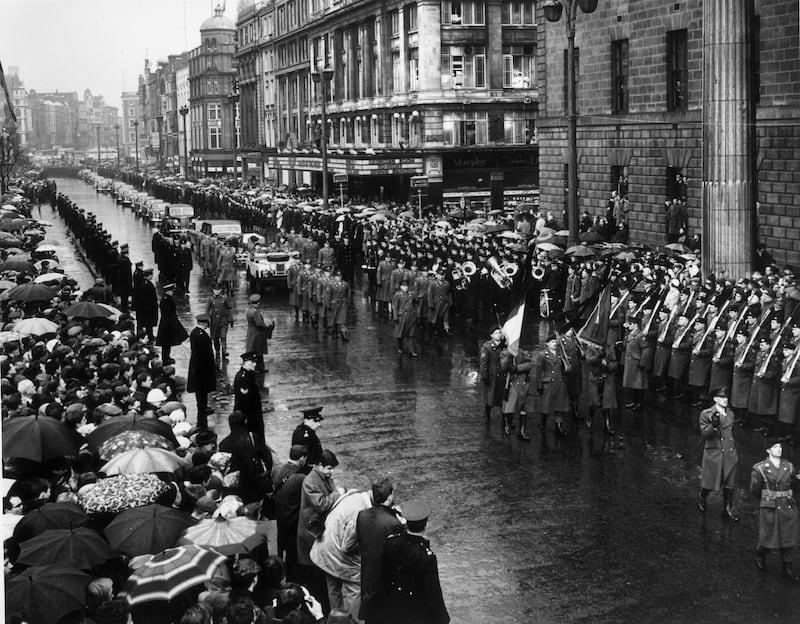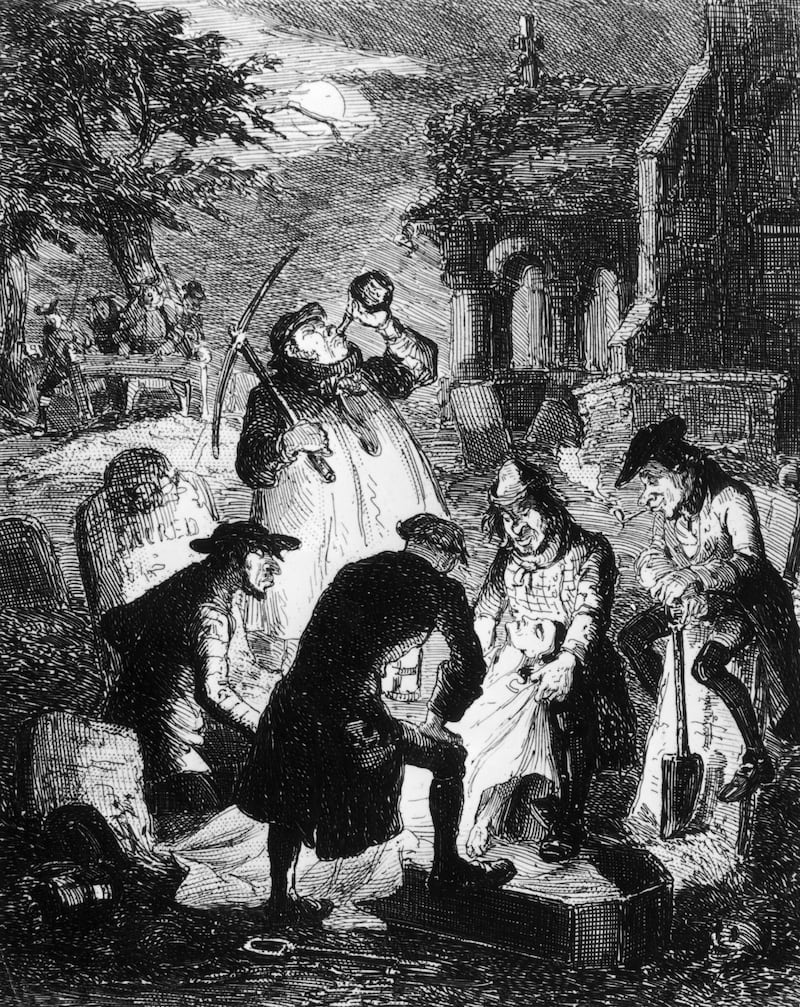“I love cemeteries,” the social historian Dr Georgina Laragy tells me. And I get it, I love them too: human stories condensed into names and numbers. The dash between the dates of birth and death is such a short, slim line, yet on a headstone represents the singular mystery of each existence. Laragy is also fascinated by Ireland’s relationship with death. She wrote her master’s dissertation on the history of melancholia. Writing a PhD on the history of suicide in Ireland drew her into “the world of death, dying and burial”.
Ireland has always “done death a little differently”, Laragy says. “We have a sense of the devastation death can bring to families and communities, and how people need support. We don’t expect people to get over it straight away. In other cultures there is a sense that you can go to therapy, that grief is something to be medicalised, that it’s something ‘wrong’. But it’s a totally normal reaction to loss and bereavement and the fact that you’re never going to see the person again.”
Laragy is the Dublin Cemeteries Trust assistant professor in public history and cultural heritage at Trinity College Dublin. The trust is the organisation that runs the five cemeteries and three crematoriums of Dardistown, Glasnevin, Goldenbridge, Newlands Cross and Palmerstown.
“Graves and cemeteries are important spaces – even more so recently, as we’ve had controversies about where people are buried, and the emergence of awareness around cillíní, or unofficial burial grounds,” she says, referring to the Tuam mother-and-baby home, where 796 children were buried in septic tanks. In June a team of forensic investigators was tasked with exhuming, analysing and identifying the remains. Repatriation of remains held in Irish museums and universities also made headlines recently: in July a reburial ceremony was held on Inishbofin for 13 400-year-old human skulls taken by Trinity academics in 1890; Linda Doyle, the university’s provost, apologised to the islanders.
READ MORE
The Irish way of death is becoming an increasingly popular area of public history, which is to say information that is produced outside teaching spaces both by and for a wider audience. As repositories of public and social history and collective memory, burial grounds are invaluable sources of information. Although Laragy believes the Decade of Centenaries helped to insert the history of everyday life into the narrative, “the independence movement and everything that led up to the Revolution dominated Irish historiography. That was inflected by the Troubles as well, so it was both current and about the past. It’s a very powerful narrative which we all learn at school, but for me it wasn’t the history of ordinary people.”

Recently, academic interest and public curiosity about the lives and deaths of our ancestors began to converge. “Family-history resources have gone through the roof. It was such a radical move by the National Archives to make the 1901 and 1911 census freely available. In other countries you have to pay for it,” Laragy says. She teaches on a short summer course for primary teachers called Delving into Your Local Heritage Starting with Cemetery and Graveyard, which shows how to use burial grounds as a learning resource for children. “You can talk about erosion by looking at monuments and how they weathered, and talk about maths by calculating dates and ages. You can look at place names, townlands, surnames. You have everything there.”
[ Three Steps to Heaven - Frank McNally on an ancient Irish funeral customOpens in new window ]
Glasnevin is of such unique social, cultural and historical significance that it’s known as Ireland’s National Cemetery, yet it is less than 200 years old. Ireland’s population exploded between 1750 and the Famine, but in the early 1800s there were no Catholic cemeteries. In 1828 Daniel O’Connell established the Dublin Cemeteries Committee to provide dignified burial space for those of all religions and none. With a design based on Highgate Cemetery, in London, and Père Lachaise, in Paris, and originally named for the surrounding townland of Prospect, Glasnevin Cemetery opened in February 1832. With its original nine acres now expanded to 124 acres, it is the final resting place of almost 1.5 million people (and counting: it’s still operational). The first funeral, that of 11-year-old Michael Carey, from Francis Street, took place the day after it opened. What was it was like for his family to return home, leaving their little boy entirely alone, buried in a vast, silent field?
People who went to the UK from Ireland were often very poor. Many ended up in institutions. And the disruption to familial networks was such that bodies were less likely to be claimed
— Dr Georgina Laragy
Glasnevin was Ireland’s first “garden cemetery”. In previous centuries, cemeteries were in the heart of urban spaces, with some even used as marketplaces. In the 19th century, however, advances in knowledge about public health and disease, plus improvements in sewerage and water systems, meant that the cheek-by-jowl coexistence (so to speak) of the dead and the living became problematic. Establishing cemeteries outside city centres not only solved sanitation problems but also created recreational spaces. “In an urban area they were often the only green spaces, so were used for lots of different things. People used to have picnics or excursions there,” Laragy says.
“We can tell a lot about the culture of the place we’re looking at by how they treat the dead body,” she adds, giving the example of The Wake, a painting by 18th-century Cork artist Nathaniel Grogan which depicts a corpse laid out in a barn. The room is packed with people playing dice, talking in groups, drinking around a table and sitting by the fire. “It shows the centrality of the dead body, and the way it’s just natural. It speaks to the continuity of the dead person within the community of the living.”

In her determination to “chip away at small parts of this history of burial”, Laragy has organised a free two-day conference, a collaboration between Trinity’s history department and Dublin Cemeteries Trust. Speakers at The Dead Body in Modern Ireland include Julia Matthias, a PhD student at Queen’s University Belfast, whose innovative research examines 80 years of the lost history of London Irish whose bodies were dissected under the Anatomy Act. The Murder Act of 1752 stipulated that only corpses of executed criminals could be used to teach anatomy, so creating the widespread illegal practice of “grave robbing”, when the demand for bodies outstripped supply. The 1832 Anatomy Act decreed that anyone who died in a prison, asylum or workhouse, and wasn’t claimed by family within 48 hours, could have their body sent to a medical school.
“People who went to the UK from Ireland were often very poor. Many ended up in institutions,” Laragy says. “And the disruption to familial networks was such that bodies were less likely to be claimed.” Previous studies mostly assumed “the poor” was a relatively homogenous group, largely dismissing ethnicity. Matthias uses medical, poor-law, coroner and prison records to reveal the hidden stories of forgotten Irish who played a crucial role in medical history after their deaths.
[ How we say goodbye to the deadOpens in new window ]
Other conference topics include the need for historians to treat the dead body as a piece of evidence, and burials associated with the Bessborough mother and baby home, in Cork.
John Gibney, a historian working on the Royal Irish Academy’s Documents on Irish Foreign Policy project, will talk about Roger Casement’s remains and their repatriation in the 1960s; he has painstakingly examined decades of correspondence between the Irish and British governments. Casement was executed for treason in Pentonville Prison in London in 1916 and buried in an unmarked grave in its yard. Despite his family’s attempts to have his body repatriated – his sister bought a plot for him in Glasnevin in 1925 – it was almost 50 years before his body was exhumed from its waterlogged grave and reinterred in Glasnevin. Casement himself wanted to be buried at Murlough Bay, on the Antrim coast. As Laragy drily notes, “The Irish government were trying to honour his wishes, but nobody went as far as to give the man what he wanted.”
The Dead Body in Modern Ireland runs at Trinity College Dublin on Thursday, September 21st, and at Glasnevin Cemetery on Friday, September 22nd; the event is booked out




















